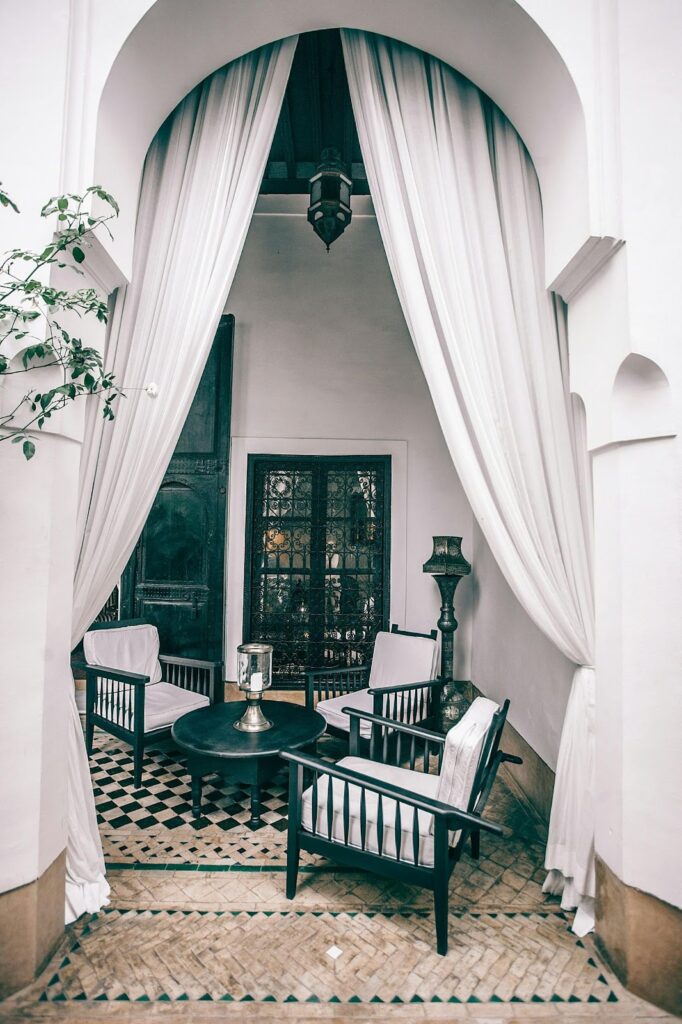Eco-Friendly Home Decor Ideas
By jagwalhome
Are you planning to remodel your home and want to adopt a greener lifestyle? Here’s how Habitat ReStores can help you make sustainable and stylish choices. learn how to decor your home with Eco friendly decorating ideas and step by step guide
In today’s rapidly evolving world, sustainability is no longer an option but a necessity. As we become more aware of our environmental footprint, the demand for eco-friendly solutions, especially in home decor, continues to grow. Embracing eco-friendly decor not only reduces waste and pollution but also creates healthier and more meaningful living spaces. Here’s an insightful guide on the importance of eco-friendly home decor and practical ideas to help you design a sustainable sanctuary.
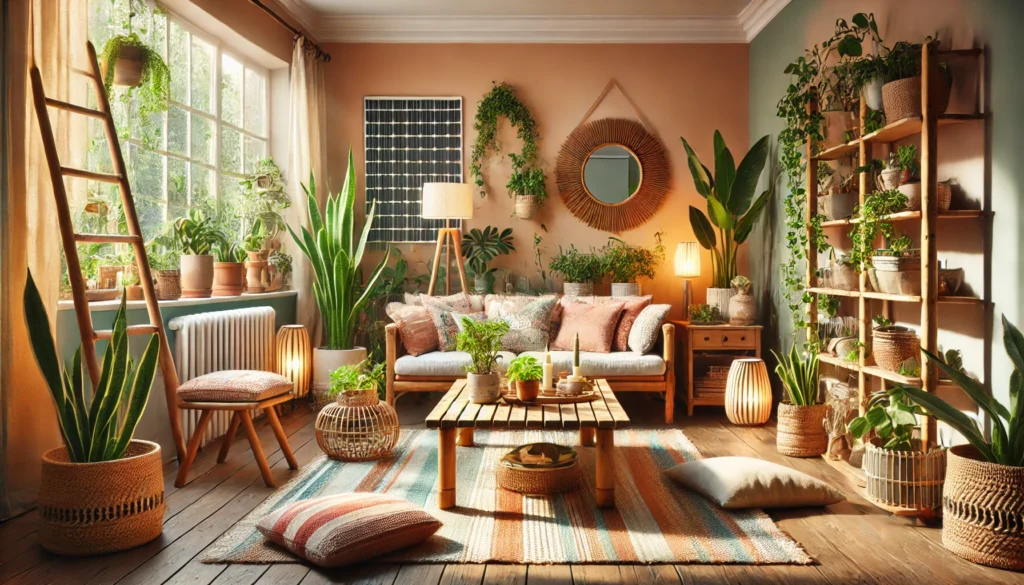
Why Choose Eco-Friendly Home Decor?
Eco-friendly home decor holds significant value for three key reasons:
Environmental Impact
Traditional home decor often involves processes and materials that harm the environment. For instance, the unsustainable harvesting of wood for furniture contributes to deforestation and increased carbon emissions. In contrast, eco-friendly decor relies on sustainable methods and materials, significantly reducing resource depletion and pollution.
Consider using reclaimed wood, a material often sourced through Habitat’s Deconstruction Service. Reclaimed wood prevents additional deforestation and gives a second life to existing materials, contributing to a circular economy.
Health Benefits
Many conventional home decor items contain toxic chemicals that can negatively affect indoor air quality. Opting for eco-friendly alternatives such as natural fiber rugs, low-VOC paints, and untreated, sustainable furniture can improve your indoor environment and enhance your overall well-being.
Economic Benefits
Although eco-friendly products might have a higher upfront cost, their durability ensures long-term savings. Moreover, energy-efficient options like LED lighting and sustainable appliances can significantly lower utility bills. Habitat Charlotte Region ReStores provide an affordable way to find reused items that align with your budget and sustainability goals.
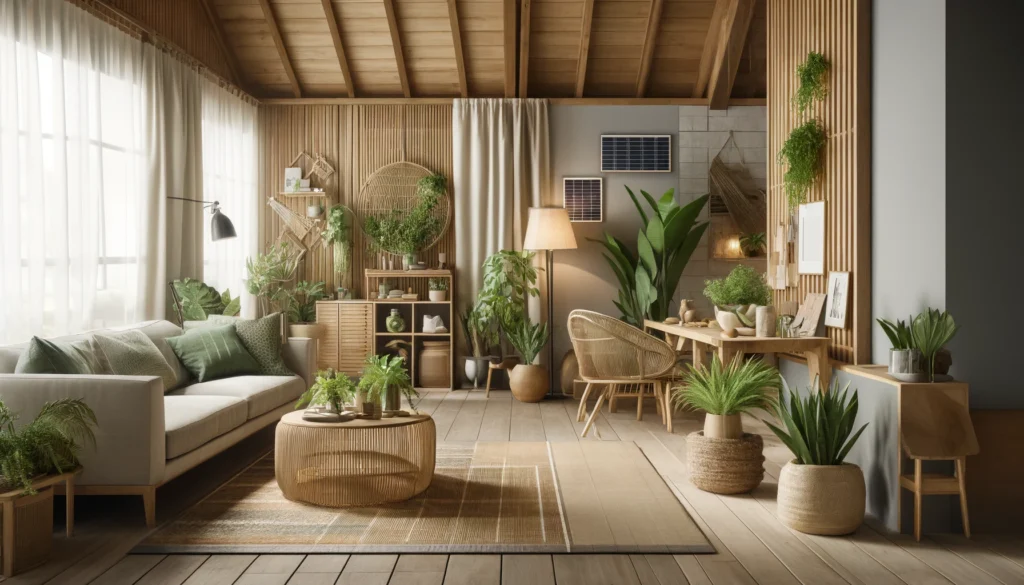
Transform Your Home: Eco-Friendly Decor Ideas
Recycled and Upcycled Materials
Choose decor crafted from recycled materials like glass, metal, or wood. Upcycling gives old items new purpose—a ladder transformed into a bookshelf or bottles repurposed into vases are just a couple of creative examples. Habitat Charlotte Region ReStores offer countless options to inspire your upcycling journey.
Sustainable Materials
Decorate with materials like bamboo, cork, or organic cotton. Bamboo, a renewable resource, is versatile enough for flooring, furniture, and textiles. Cork serves as an excellent option for flooring and wall tiles, while organic cotton works beautifully for curtains and bedding.
Energy-Efficient Lighting
Switch to LED bulbs and energy-efficient fixtures. LEDs use up to 90% less energy than traditional incandescent bulbs and last significantly longer, making them a sustainable choice for lighting your home.
Non-Toxic Paint
Low-VOC and zero-VOC paints enhance indoor air quality by eliminating harmful off-gassing. Opt for these alternatives to create a healthier, safer environment while adding color to your walls.
Houseplants
Enhance your space with indoor plants like snake plants, pothos, or spider plants. These not only purify the air by absorbing toxins but also add natural beauty and tranquility to your home.
Natural Fibers
Choose rugs, curtains, and linens made from materials like jute, linen, or wool. These biodegradable, renewable fibers are free from synthetic chemicals, making them a healthier choice for your home decor.
Eco-Friendly Wall Art
Look for wall art crafted from reclaimed wood, recycled metal, or natural fibers. Supporting local artists also reduces the carbon footprint associated with shipping artwork while bringing unique charm to your decor.
Second-Hand and Vintage Finds
Explore thrift stores and online marketplaces for one-of-a-kind pieces. Habitat Charlotte Region ReStores are treasure troves of second-hand items, ranging from vintage furniture to pre-loved decor that can add character to your home while reducing waste.
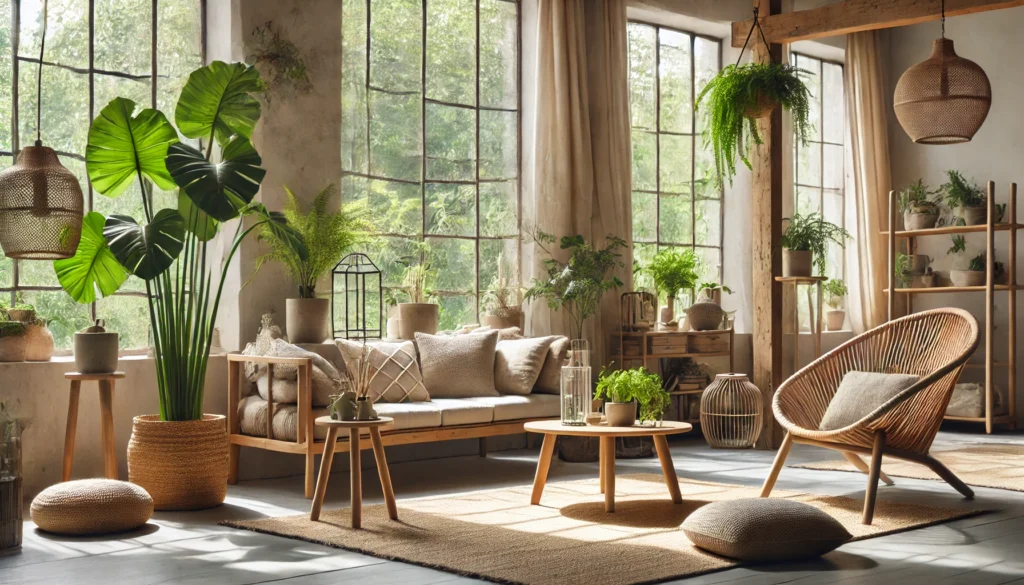
Spotlight on Habitat Charlotte Region ReStores
Habitat Charlotte Region ReStores are invaluable resources for eco-conscious decorators. While not every item sold is eco-friendly, purchasing second-hand goods promotes reuse and recycling. Here’s how ReStores contribute to sustainability:
- Reuse and Recycle: ReStores keep goods out of landfills, reducing waste and minimizing the demand for new production.
- Affordable Options: With a range of home decor items at lower prices, ReStores make sustainable decorating accessible to everyone.
- Support a Good Cause: Proceeds from ReStores fund affordable housing projects, creating meaningful community impact.
Items You Can Find at Habitat Charlotte Region ReStores:
- Furniture: Gently used sofas, chairs, tables, and dressers, some made from sustainable or reclaimed materials.
- Building Materials: Recycled tiles, reclaimed wood, and other construction materials for your DIY projects.
- Home Accessories: Mirrors, lamps, and picture frames, often crafted from recycled or sustainable components.
- Appliances: Energy-efficient models that are fully functional and donated by previous owners.
- Textiles: Second-hand curtains, rugs, and linens in great condition or made from natural fibers.
A Greener, More Stylish Home Awaits
Creating an eco-friendly home doesn’t have to be overwhelming. Start small by replacing traditional light bulbs with energy-efficient LEDs or incorporating a few houseplants. Gradually, you can expand to larger changes like introducing reclaimed furniture or sustainable flooring.
By choosing eco-friendly materials, supporting stores like Habitat Charlotte Region ReStores, and adopting a mindful approach to consumption, you can design beautiful and sustainable living spaces that protect the planet and improve your well-being. Every conscious choice contributes to a greener future, proving that style and sustainability can harmoniously coexist.
Join Habitat’s Mission
Habitat for Humanity of the Charlotte Region relies on donors, volunteers, and partners to continue its vital work. Whether you’re interested in sustainable homeownership, volunteering, or donating, your involvement can make a difference. Together, through faith, passion, and innovation, we can build homes, communities, and hope for a better tomorrow.
Top 10 Eco-Friendly Home Decorating Ideas
1. Recycled and Upcycled Materials
Embrace creativity by incorporating decor made from recycled or upcycled items. For example, transform an old ladder into a unique bookshelf, or repurpose glass bottles as decorative vases filled with flowers or fairy lights. These small changes not only reduce waste but also add a personalized and artistic touch to your home.
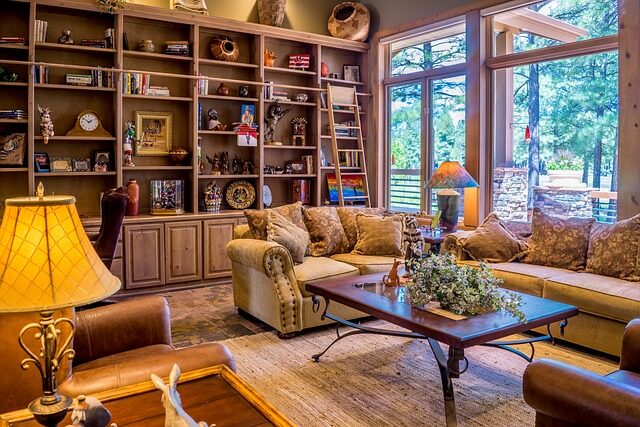
Pros:
- Saves Money: You can turn old stuff into beautiful decor without spending a lot.
- Unique Look: Each item tells its own story and makes your home feel special.
- Eco-Friendly: You’re helping the planet by reducing waste.
Cons:
- Takes Time: Hunting for materials and transforming them can be a bit time-consuming.
- Not Always Durable: Some upcycled items might not last as long as new ones.
- Style Match: It can be tricky to blend these items with a modern look.
2. Sustainable Furniture
Invest in furniture crafted from sustainable materials such as bamboo, reclaimed wood, or cork. Bamboo grows rapidly, making it a highly renewable resource, while reclaimed wood gives a second life to previously used timber. Not only are these materials eco-friendly, but they also exude a rustic and earthy charm that complements modern and traditional interiors alike.

Pros:
- Strong and Long-Lasting: Materials like bamboo and reclaimed wood are built to last.
- Beautiful Look: Adds a cozy, natural vibe to your space.
- Environmentally Friendly: Helps reduce deforestation and supports green practices.
Cons:
- Pricey: Sustainable furniture often costs more upfront.
- Hard to Find: Authentic eco-friendly options aren’t always easy to locate.
- Maintenance Required: Wood and natural materials need regular care to stay in good shape.
3. Energy-Efficient Lighting
Switching to LED bulbs and energy-efficient lighting fixtures is a simple yet impactful way to reduce your carbon footprint. LEDs consume up to 90% less energy compared to traditional bulbs and last significantly longer. Pair them with dimmers or motion sensors to further save energy and create customizable lighting moods.
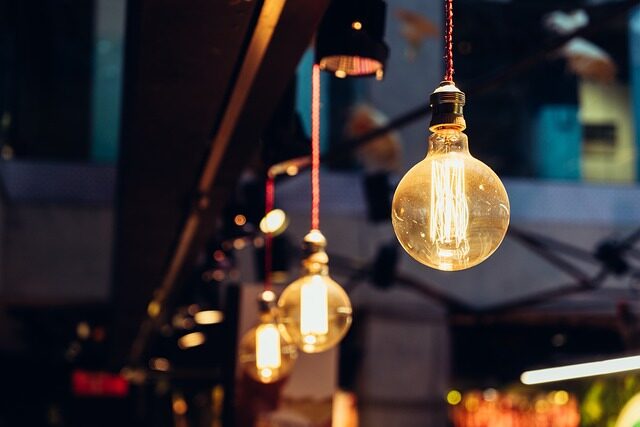
Pros:
- Low Bills: LED bulbs use less energy, so you save on electricity.
- Long-Lasting: They work for years without needing a replacement.
- Good for the Planet: Uses less energy, reducing your carbon footprint.
Cons:
- Costs More Initially: LED bulbs and fixtures are pricier at first.
- Light Quality: Some people miss the warm glow of traditional bulbs.
- Recycling Needed: These bulbs should be properly disposed of to avoid harm.
4. Low-VOC Paint
Refresh your walls using paints with low or zero volatile organic compounds (VOCs). These paints are free from harmful chemicals that can negatively affect indoor air quality. Available in a wide range of colors, they allow you to beautify your space without compromising on health or sustainability.

Pros:
- Healthier Home: Reduces harmful chemicals, making indoor air safer to breathe.
- Environmentally Safe: A greener option for painting your home.
- Variety of Colors: Available in a range of shades to fit any style.
Cons:
- Costs More: Low-VOC paints can be slightly more expensive.
- Extra Coats: Sometimes, you need more layers to get the perfect finish.
- Limited Choices: Not all brands or finishes come in low-VOC options.
5. Houseplants for Natural Decor
Houseplants are not only visually appealing but also excellent for improving indoor air quality. Varieties like pothos, spider plants, and snake plants are low-maintenance options that thrive in different lighting conditions. Place them in ceramic pots, macramé hangers, or reclaimed containers for an eco-friendly and refreshing touch.
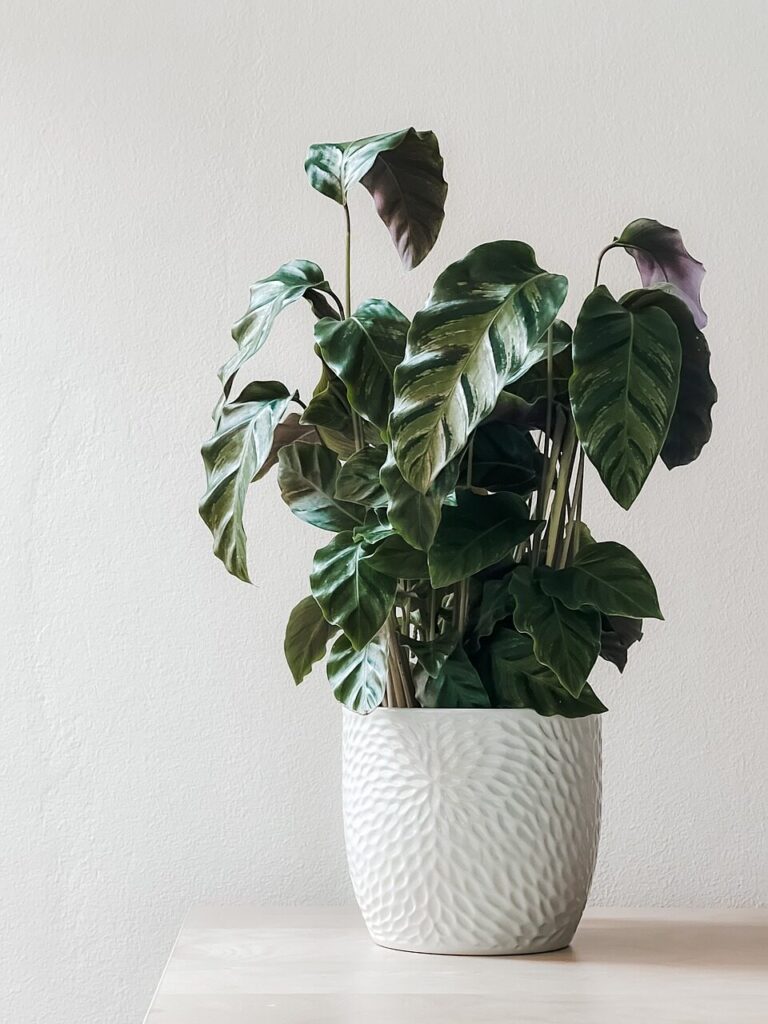
Pros:
- Cleans the Air: Plants help remove toxins, making your home healthier.
- Relaxing Atmosphere: Adds a fresh, calming vibe to your space.
- Affordable Beauty: Easy to find and doesn’t cost a lot.
Cons:
- Needs Care: Watering and upkeep are necessary to keep them alive.
- Allergy Risk: Some people might react to certain plants.
- Pet Safety: Many houseplants can be dangerous for cats and dogs if eaten.
6. Natural Fiber Textiles
Choose textiles like rugs, curtains, and bed linens made from natural fibers such as jute, wool, or organic cotton. These materials are biodegradable and free from harmful chemicals, making them a sustainable choice. Handwoven or artisanal options add unique textures and stories to your decor.

Pros:
- Environmentally Friendly: Materials like jute and organic cotton break down naturally.
- Strong and Durable: Perfect for areas with heavy use.
- Adds Warmth: Creates a cozy, inviting look.
Cons:
- Expensive: Natural fiber items often cost more than synthetic ones.
- Hard to Clean: Spills or stains can be tricky to remove.
- Can Be Scratchy: Some textiles might not feel soft on the skin.
7. Second-Hand and Vintage Finds
Shopping for second-hand or vintage decor items is both budget-friendly and environmentally conscious. Explore thrift stores, flea markets, or online platforms to discover unique pieces like antique mirrors, retro lamps, or classic furniture. These treasures not only reduce landfill waste but also bring a timeless elegance to your home.
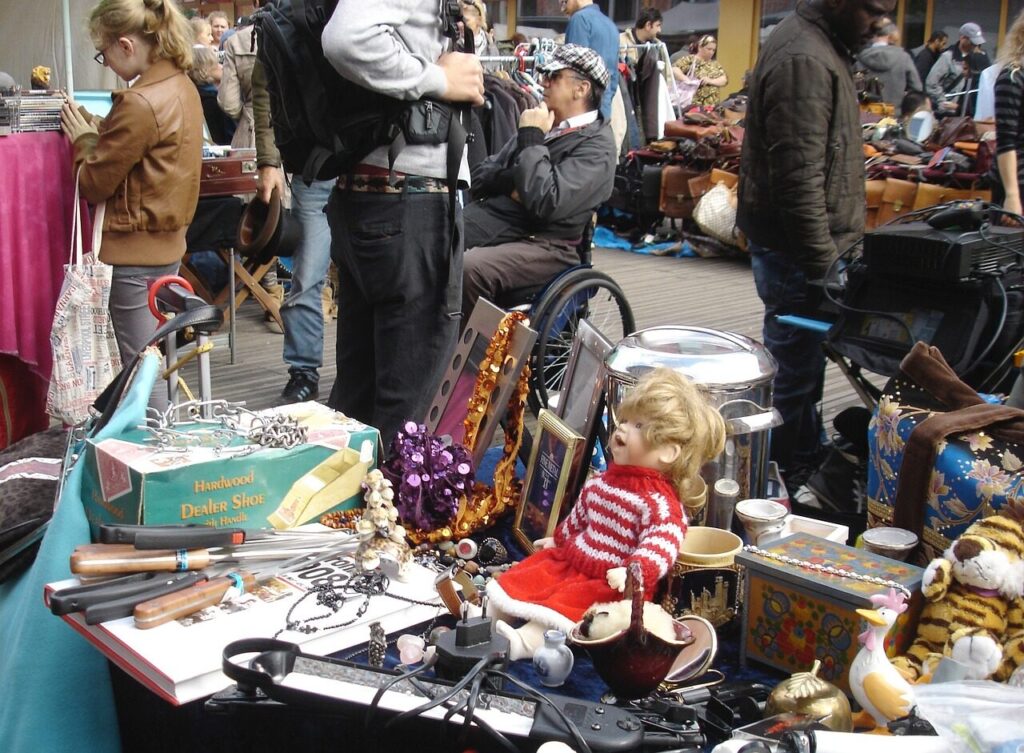
Pros:
- Budget-Friendly: You get stylish decor for less money.
- Full of Character: Adds a unique, nostalgic charm to your home.
- Eco-Smart: Buying used items reduces waste and new production.
Cons:
- Wear and Tear: Pre-loved items might show signs of aging.
- Time-Consuming: Finding the perfect piece can take some effort.
- Doesn’t Fit All Styles: Vintage might clash with ultra-modern interiors.

Harness the power of the sun with solar-powered decor such as garden lights, indoor lamps, or chargers. These devices are energy-saving and cost-effective, making them an ideal addition to eco-friendly households. Use solar-powered string lights for a magical touch to your outdoor spaces.
Pros:
- Energy Saver: Cuts down on electricity costs by using the sun.
- Great Outdoors: Ideal for garden lights and outdoor accents.
- Environmentally Kind: Reduces reliance on non-renewable energy.
Cons:
- Expensive Start: Solar-powered items cost more initially.
- Needs Sunlight: Not effective if placed in shady areas.
- Occasional Cleaning: Solar panels require cleaning to work efficiently.
9. DIY Eco-Art
Unleash your creativity by crafting eco-friendly art for your home. Use reclaimed wood to create rustic wall hangings, or repurpose old fabrics into vibrant tapestries. Even items like bottle caps, paper scraps, or driftwood can be transformed into stunning art pieces that reflect your sustainable values.

Pros:
- Fun and Creative: Lets you explore your artistic side.
- Personal Touch: Customizes your home decor to reflect your personality.
- Budget-Friendly: Uses recycled materials or inexpensive supplies.
Cons:
- Takes Time: Crafting decor isn’t always quick or easy.
- Skill Level: Not everyone feels confident in their DIY abilities.
- Durability Issues: Handmade items might not last as long as store-bought ones.
10. Smart Home Technology
Upgrade your home with smart devices like thermostats, energy monitors, or eco-friendly appliances. Smart thermostats learn your habits and adjust temperatures to optimize energy usage, while energy-efficient appliances reduce utility costs. Together, these technologies contribute to a more sustainable and comfortable lifestyle.

Pros:
- Efficient and Smart: Devices like smart thermostats save energy and are easy to use.
- Convenient: Control appliances from your phone or voice commands.
- Saves Money Over Time: Reduces energy bills in the long run.
Cons:
- Expensive Setup: Smart devices can be costly to install.
- Tech Challenges: Learning how to use them might take time.
- Privacy Concerns: Some devices may collect personal data.
FAQs of eco-friendly home decorating ideas
1. What are the easiest eco-friendly changes I can make in my home decor?
If you’re just starting, small steps can make a big impact. Begin by incorporating houseplants for a natural touch and better air quality. Switching to LED bulbs is another simple yet effective change that saves energy. Opt for second-hand decor or upcycled items like repurposed glass jars or vintage frames to add charm without extra cost. These changes are budget-friendly, easy to implement, and immediately improve your space.
2. Are eco-friendly materials durable compared to traditional options?
Yes, many eco-friendly materials are as durable, if not more so, than traditional options. For instance, bamboo furniture is incredibly sturdy and long-lasting. Similarly, reclaimed wood offers high-quality durability. While some upcycled or recycled decor items might not last as long, sustainable materials like cork and natural textiles like wool or organic cotton hold up well with proper care.
3. How can I make my home eco-friendly on a budget?
You don’t need a big budget to go green! Shopping at thrift stores for vintage finds or DIYing decor with recycled materials can be very cost-effective. Adding solar-powered lights for outdoor areas or swapping out regular bulbs for LEDs is affordable and saves money in the long run. Start with small steps like using natural fiber rugs or updating your walls with low-VOC paint, which improves indoor air quality without breaking the bank.
4. Do solar-powered decor items work well indoors?
Solar-powered items are best suited for outdoor spaces where they can receive direct sunlight during the day. However, if you want to use them indoors, place them near windows where they can still absorb sunlight. Alternatively, you can look for hybrid solar-powered decor, which comes with a backup charging option to ensure they stay functional.
5. How do I ensure the houseplants I choose are safe for pets?
When choosing houseplants, research which ones are non-toxic for your pets. Safe options include spider plants, Boston ferns, and areca palms. Always avoid plants like pothos, philodendrons, and lilies, which can be harmful to cats and dogs. For extra safety, place plants in spots your pets can’t reach, such as hanging baskets or high shelves.
6. Are natural fiber textiles better for allergies?
Yes, natural fiber textiles like organic cotton, jute, or wool are often better for people with allergies. These materials are free from harsh chemicals and synthetic additives, which can trigger sensitivities. Additionally, they don’t trap as much dust or allergens as synthetic fabrics, making them a healthier choice for bedding, curtains, and rugs.
7. What’s the difference between low-VOC and zero-VOC paint?
Low-VOC paint contains a reduced level of volatile organic compounds (VOCs), which makes it safer for indoor use compared to regular paint. Zero-VOC paint, as the name suggests, has no detectable VOCs, making it the healthiest choice for your home. While zero-VOC paints are slightly more expensive, they are worth the investment, especially for nurseries or bedrooms.
8. How can I balance vintage decor with a modern home style?
Blending vintage finds with modern decor can create a unique, stylish look. Choose vintage items like mirrors, frames, or side tables that complement your modern furniture. Keep the color palette cohesive—neutral tones or matching accents can help tie everything together. Mixing textures, like pairing a vintage wooden coffee table with sleek modern sofas, adds depth and character to your space.
9. Is smart home technology truly eco-friendly?
Yes, smart home technology like smart thermostats and energy monitors can significantly reduce your energy usage. These devices help you monitor and control your electricity consumption more efficiently, often leading to lower utility bills. However, the environmental impact of manufacturing and disposing of electronic devices should also be considered. To maximize their eco-friendliness, choose reputable brands that prioritize sustainable practices.
10. How can I make eco-friendly choices without compromising on style?
Eco-friendly doesn’t mean boring or plain! Choose sustainable furniture made from bamboo or reclaimed wood, which often has a rustic, elegant look. Add pops of color with natural fiber textiles like jute rugs or organic cotton cushions. Use upcycled materials creatively, like a repurposed ladder shelf or wine bottle vases, to add unique charm. Combining sustainability with your personal style creates a home that’s both beautiful and environmentally responsible.

